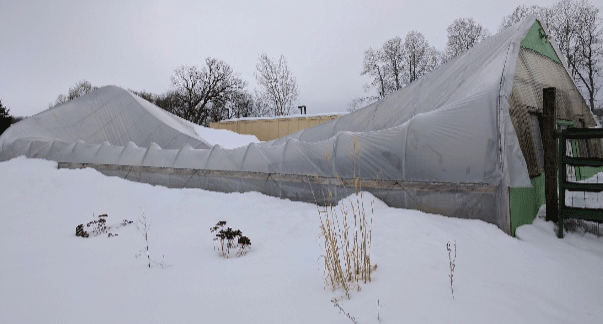Colgate Community Garden Greenhouse Collapses After Spring Break Snowstorm
Faculty and students returned from break, unpleasantly surprised by the implosion of the much-loved greenhouse near the Townhouses.
Over spring break, the three-day-long snowstorm, Stella, hit Hamilton, resulting in the collapse of Colgate’s greenhouse under the weight of the snow. This event impacts the various people working with and benefitting from the greenhouse, including the Green Thumbs (a student-run club), the Hamilton Food Cupboard and even Colgate’s own dining services. Two Colgate faculty members, John Pumilio and Beth Roy, commented on the current state of the greenhouse and future plans for the greenhouse as of its collapse. John Pumilio, Colgate’s Director of Sustainability, discussed past work with the greenhouse, and emphasized its importance to students regarding sustainability education.
This student-run garden project began in 2010 when students conducting a feasibility study along with the Green Thumbs decided to start up a greenhouse to help students engage in producing their own food. The greenhouse, originally located near the Newell Apartments, was moved to the townhouses due to frequent flooding, resulting in the destruction of the gardens. The school bought an existing greenhouse at the Townhouses, and has used this structure for its garden project ever since, with improvements to the outward plastic constructed in 2015.
Pumilio stressed the importance of the gardens to the various groups that work with them. He noted that allowing students to produce their own food creates greater appreciation of sustainable practices. Working in the gardens educates students in health practices, land use, carbon emissions, pesticide use and labor, all of which directly applies to the key discipline of sustainability studies.
Furthermore, the food produced in these gardens goes to both the Hamilton Food Cupboard and to Colgate Dining Services. Pumilio recognized the impact that the loss of this resource would have on sustainability education as well as the places that the food goes to.
Pumilio also touched on the future of the greenhouse, which he claimed is uncertain at the moment. Currently, the greenhouse is structurally unstable and dangerous to investigate, and therefore they are still waiting for an assessment on the degree of damage. Pumilio also briefly discussed the rebuilding of the greenhouse, which is just as uncertain as the damages done. The greenhouse directors are looking into Colgate’s insurance to see if rebuilding is a possibility, but they are still unsure how the greenhouse will be fixed.
Beth Roy, the Garden Manager, added to the discussion of the greenhouse. Roy works directly with students while supervising the garden in the spring, summer and fall. Roy discussed the yearly activities of the gardens, with spring dedicated to seeding, summer requiring growing and tending by paid garden interns, and spring used to prepare for the farmstand at the Coop.
Crops such as lettuce and other greens, tomatoes, peppers, cucumbers and more are produced during the year. Roy spoke to the various functions of the greenhouse to the Colgate and Hamilton communities.
“The garden ultimately extends the growing season, with work done April through December,” Roy said. “The amounts of food that the greenhouse provides to both Colgate and local organizations [is substantial]: with nearly 4,000 lbs of produce grown per year, the garden donates half to the Hamilton Food Cupboard and the other half is sold to Chartwells or through the farmstand in the Coop.”
Roy then commented on future plans with the greenhouse. Due to its full collapse, the greenhouse will most likely need to be torn down completely, although Roy says this conclusion will not be certain until proper assessment of the damages is complete. Roy is hopeful of rebuilding, as Colgate’s insurance plan thus far has helped the gardens’ maintenance and structural upkeep, although this insurance plan is still being looked into as well.
Roy addressed the loss of storage for tools and equipment, as the greenhouse formerly provided this space. Now, Roy and other garden directors will have to find storage space elsewhere. Finally, the summer interns will still work, but the growing season may be compromised as a result of the loss of the greenhouse.
Ultimately, Pumilio and Roy were shocked by the magnitude of the damage, because of the recent modifications done to enhance the structure of the greenhouse. However, Pumilio spoke to the realities of sustainable practices on college campuses.
“This project shows that there are always some setbacks or unanticipated challenges of farming,” Pumilio said.







